With its stunning mountains, glorious waterways, and many other terrains, the state of Idaho offers an incredible variety of habitats for wildlife. Among some of the favorites for many (probably not farmers, however) are the foxes in Idaho, beautiful canine-like creatures that roam the terrain freely, swishing their bushy tails.
Most Americans are familiar with gray foxes and red foxes and often think these are the only species that live in the USA. While these are by far the most common, others exist, too, including one beautiful species found right here in Idaho, along with its common cousin the red fox.
How Many Types of Foxes Are There in the USA?
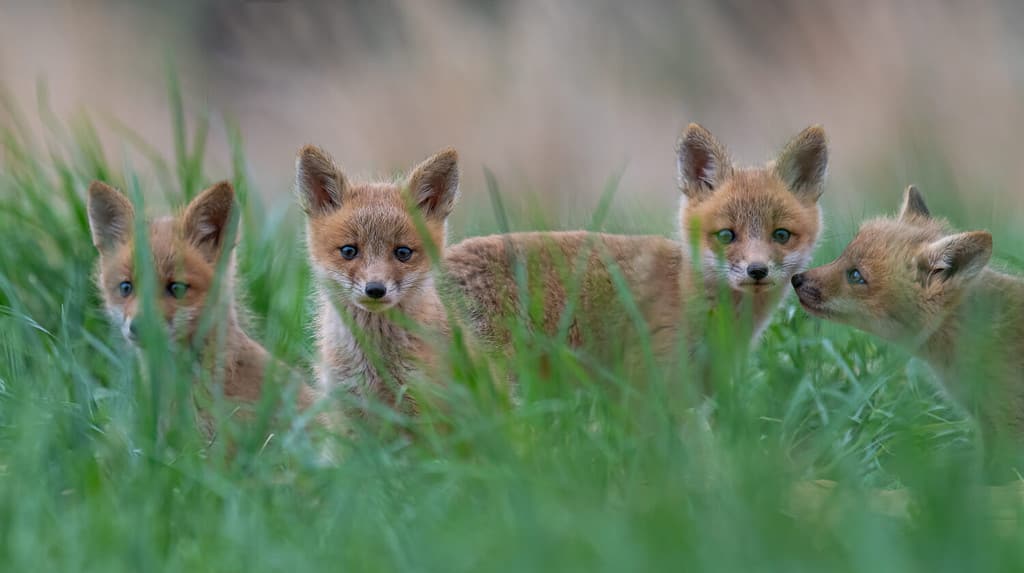
Four young red fox kits explore their terrain.
©Randy G. Lubischer/Shutterstock.com
Two species of foxes make Idaho their home: red foxes, which most of us know about, and kit foxes, a rarer species. Across the USA, two additional species of foxes make their homes: gray foxes and arctic foxes. Gray and red foxes are the most common species and make their homes in nearly every state in America and throughout much of Canada.
Red Fox (Vulpes vulpes)
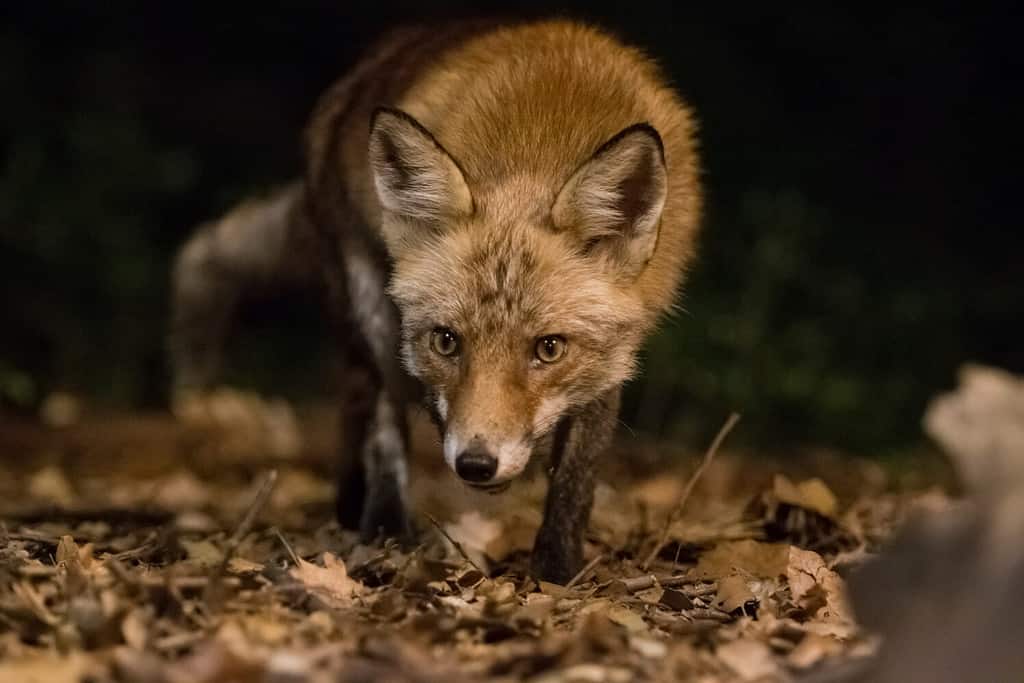
Red foxes mostly seek out food at nighttime.
©Daniel Rodriguez Garriga/Shutterstock.com
The most common fox species in the United States, the red fox, or Vulpes vulpes, is the largest of the true fox species. The beautiful animals belong to the order Carnivora and live in North America, Asia, Europe, and parts of North Africa. They’ve also been introduced to Australia after the introduction of rabbits to help reduce the population. Male red foxes are known as tods or dogs, females are known as vixens, and young foxes are known as kits.
Adaptability particularly describes this species of fox as they are the most able to survive in many terrain types (thus their vast distribution throughout the world). Red foxes aren’t just a single “type,” however, with 45 subspecies of the fox across the planet. You’ll find two categories of red foxes, with northern red foxes in Idaho and the smaller basal southern grey desert foxes living in other regions like Asia and North Africa.
Description

Red foxes usually have rich red coats but may have other color morphs.
©iStock.com/Rejean Bedard
A red fox has short limbs and an elongated body, a long, full, fluffy tail longer than half the body length. They have oval, vertically oriented pupils and nictitating membranes, or third eyelids that move when their eyes are closed. Each forepaw has five digits, hind feet have four digits and lack the dewclaws of other canids (positioned like the “thumb” on a dog’s paw).
Female red foxes tend to have smaller heads and wider nasal regions than males, as well as weighing roughly 15 to 20% less than males.
A typical red fox weighs between 6.5 and 31.0 pounds, is 1.5 to 3.0 feet long, plus a tail length of 12.0 to 22.0 inches long.
In Idaho, red foxes have denser, long, fluffier fur than red foxes in warmer climates. Their hair is silky and soft, which was a large part of why the fox fur trade had a huge boom in the early 19th Century.
And while the name is apropos of the species color in general, there are color morphs including black, silver, or a cross between silver and red (known as a cross fox). These are not the result of gray or silver foxes breeding with red foxes. Fox species do not interbreed. To identify red foxes from others, even in these color morphs, look for the distinctive, white-tipped tail.
Behavior
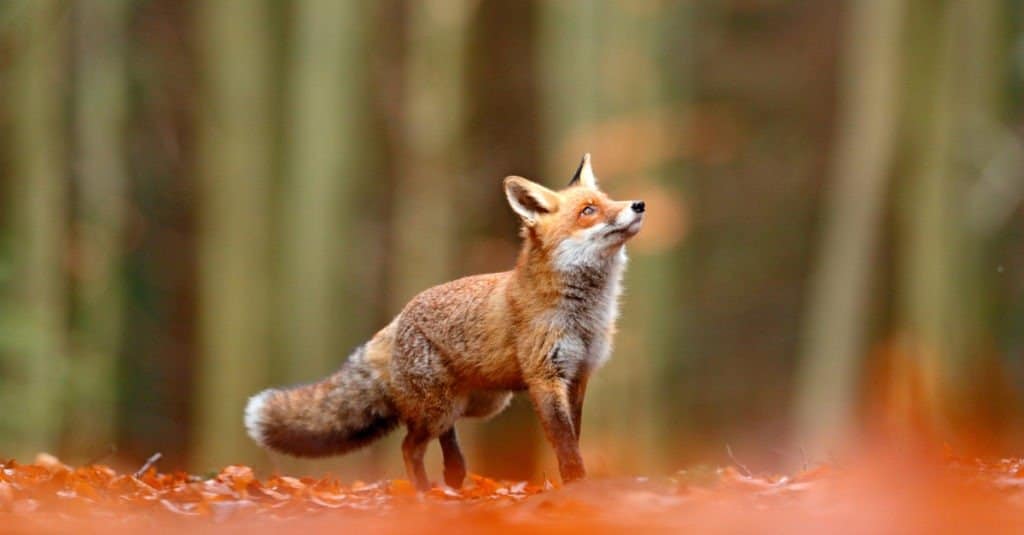
Red foxes live in mated pairs or family units in most cases.
©Ondrej Prosicky/Shutterstock.com
Usually found in pairs or small groups consisting of families (like a mated pair with their young), red foxes are semi-social animals. The young remain with their mated pair parents into adulthood, helping to care for the younger kits in their family, as well. Sometimes, males with kinship ties to multiple females will create these small groups.
Feeding primarily on small rodents such as rabbits and squirrels, foxes are also known to hunt for game birds, invertebrates, and reptiles, as well as young ungulates (larger mammals with hooves, like sheep). As needed, red foxes will also dine on fruits and vegetables to balance out their diet.
Though they do hunt a variety of other small predators, red foxes themselves are vulnerable to wolves and coyotes and larger predator birds or large cats like mountain lions.
Experiments in domestication of red foxes is underway in Russia, while others have become “human-friendly” in urban areas when humans have fed them or befriended them. These foxes remain wild, however, and should not be treated like pets.
In the wild, red foxes usually live to about 3 years, while those in captivity (such as in zoos and sanctuaries) may live to be 12 years old.
Habitat and Distribution

Red foxes have a huge distribution range and are the largest of all fox species in the world.
©iStock.com/William Chua
Red foxes range as far north as the Arctic Circle and as far south as extreme Southeast Asia and in northern parts of the Sahara Desert. In Idaho, red foxes may be found in nearly every county of Idaho, with confirmed sightings in all but 8 to 10 counties.
Urban areas, farmlands, mountains, deserts, prairie, tundra, forest, and mixed vegetation areas such as woodlands and mixed scrub ranges are the many habitat types of red foxes.
Kit Fox (Vulpes macrotis)
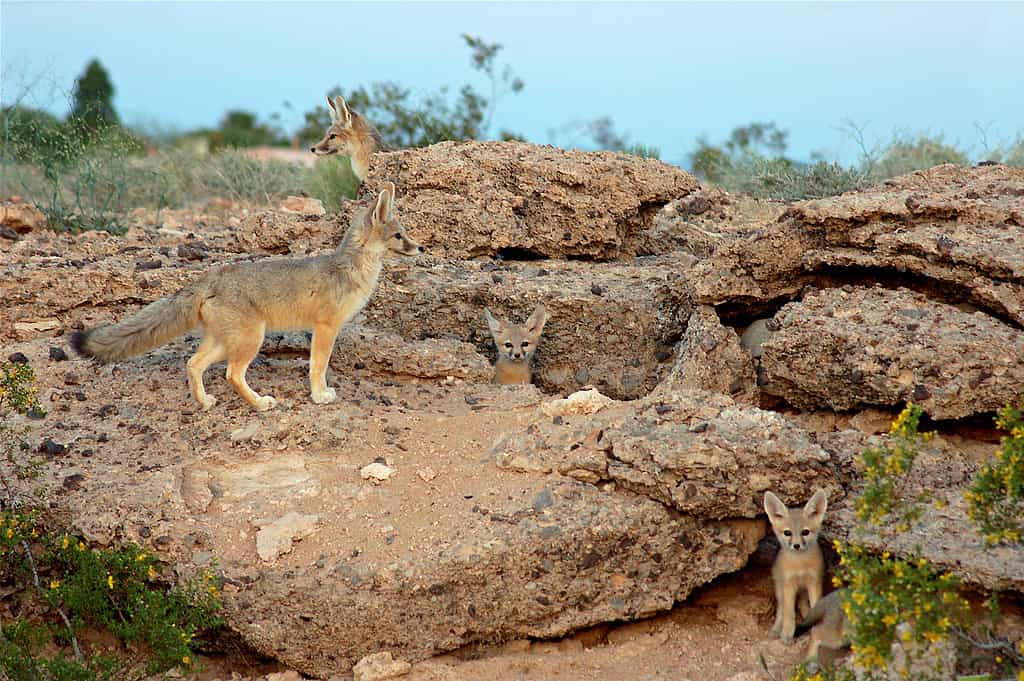
A kit fox family lives together until the young have matured and go off to form their own family units.
©iStock.com/Sherri Cassel
The lesser-known Kit fox (Vulpes macrotis) species inhabits arid and semi-arid regions most commonly in the Southwest and northern and Central Mexico. However, the unique fox has made its way into Idaho. It’s the smallest species of foxes in the United States and one of the smallest worldwide. Sometimes, folks mistake this unique fox with the fennec fox thanks to its large ears. Others mistake it for the swift fox but the species bear molecular differences that make them distinct from each other.
Description
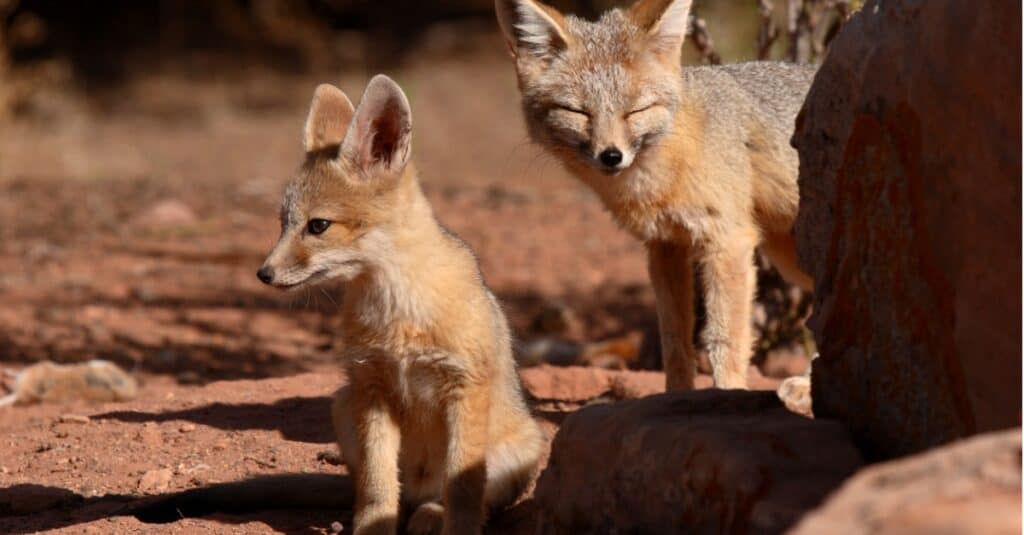
Kit foxes have large ears that sometimes cause folks to confuse them for fennec foxes.
©iStock.com/gatito33
One of the smallest species of fox and of the Canidae family overall, the kit fox has large ears which help the animal hear exceptionally well and dissipate heat. The male is slightly larger than the female of the species. On average the kit fox weighs between 3.5 and 6.0 pounds, with a body length of 17.9 to 21.1 inches, and a tail about 40% of the body length between 10.2 and 12.7 inches long.
Kit foxes adapt their coloration and texture based on their geographical locations. A grizzled or yellow-gray color is most common dorsal (upper side or back of the torso) color. These are the guard hairs with black tips or black bands separated by a white band on each hair. On the soles of their feet, Kit foxes have stiff tufts of fur to protect their feet against extreme temperatures. Muzzles on kit foxes generally run darker brown to black in color, while the tails are bushy and gray with black tips. There’s also a caudal gland pronounced with a black spot. Sometimes, folks mistake these foxes for gray foxes, but there’s no stripe along the length of its tail.
Kit foxes usually have tan or gray ears, while their backs are darker than the rest of their coats. The belly and inner of the ears of the kit fox tends towards light colors, and dark patches appear around the nose. Shoulders, flanks, and sides are usually buff to orange in color.
Behavior
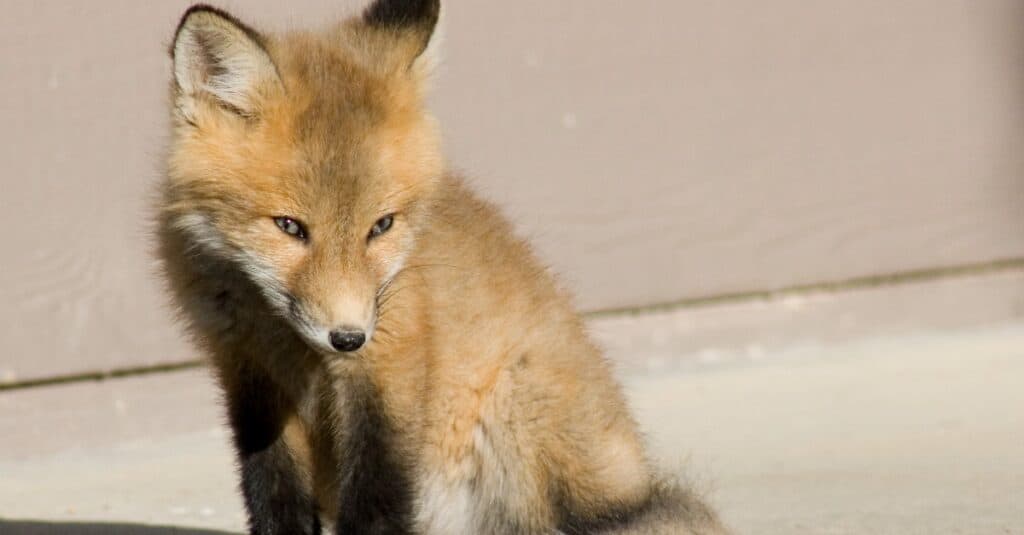
The ears of a kit fox allow it to have exceptional hearing and aid in keeping its body cooler in the desert heat.
©iStock.com/jmhite
Mostly nocturnal, you’re less likely to see kit foxes than some other species of foxes which tend toward dawn and dusk activity (crepuscular). They may venture out at dusk or dawn, as well, though less frequently, but most likely this will occur in cooler months.
Kit foxes tend to forage on their own, but they’re not particularly territorial. They live in pairs or small family groups like red foxes do and spend much of their daytime hours resting in their dens and avoiding the extreme heat of the arid regions of Idaho.
While they do dig their own dens, kit foxes may take over and modify the dens of other animals like badgers, prairie dogs, and kangaroo rats. Throughout the year, each fox pair or family unit will probably live in 11 or more dens.
Distribution and Habitat

Kit foxes live in arid and semi-arid regions throughout the western portion of the United States and parts of Mexico.
©iStock.com/gatito33
Boundaries for kit fox distribution are primarily from the arid interior of Oregon to the southwestern region of Colorado, into Nevada, Utah, southeastern California, into Arizona, New Mexico, and western Texas. They do live in Idaho but are less commonly so and are usually not spotted by humans in the area.
They prefer desert scrub, halophytic regions, grasslands, and chaparral. Usually, they prefer areas with loosely textured soils for easier den creation, though they may make their way into agricultural areas as well, especially orchards. On rare occasions, they may appear in urban areas.
The photo featured at the top of this post is © Swaroop Pixs/Shutterstock.com
Thank you for reading! Have some feedback for us? Contact the AZ Animals editorial team.







